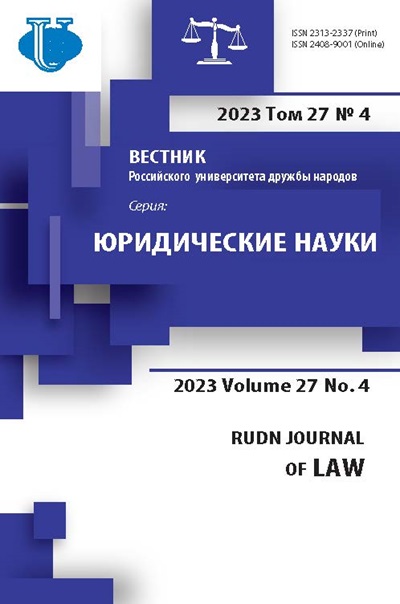Peculiarities of legal protection of natural world heritage sites in Australia on the example of the Great Barrier Reef
- Authors: Kolobov R.Y.1,2, Ditsevich Y.B.3
-
Affiliations:
- Irkutsk State University
- Irkutsk Scientific Center SB RAS
- Irkutsk Law Insitute (branch) of the University of Prosecutor’s Office of the Russian Federation
- Issue: Vol 27, No 4 (2023)
- Pages: 969-983
- Section: LAND LAW AND ENVIRONMENTAL LAW
- URL: https://journals.rudn.ru/law/article/view/36898
- DOI: https://doi.org/10.22363/2313-2337-2023-27-4-969-983
- EDN: https://elibrary.ru/KDSWXI
- ID: 36898
Cite item
Abstract
The study examines the practice of legal protection of the Great Barrier Reef World Heritage Site located in Australia. It reflects the main content of the decisions of the World Heritage Committee and the International Union for Conservation of Nature on the protection of the Great Barrier Reef, looks at the features of its management as a World Heritage Site (hereinafter also - WHS), as well as regulatory and organisational solutions aimed at preventing threats to the ecological state of the Great Barrier Reef WHS. The analysis of the legal framework and practice of protection of World Heritage Sites allows to conclude that some elements of the Australian experience can be used to strengthen the institutional and legal framework of the environmental regime of Lake Baikal. The proposal to develop a management plan for the Lake Baikal World Heritage Site in accordance with the requirements and standards of the World Heritage protection system, as well as to adopt special strategic development plans has been formulated. According to the authors, to ensure the effective development of specific management decisions, it is necessary to establish normatively the general principles of management plan formation. Based on the practice of engaging local communities in the management of World Heritage Sites and Australian experience of organising Marine Advisory Committees, the authors have verbalized a proposal to create an Advisory Council of representatives of various spheres of society, operating in the territory of the Lake Baikal World Heritage Site, environmental organisations and representatives of the public.
About the authors
Roman Yu. Kolobov
Irkutsk State University; Irkutsk Scientific Center SB RAS
Author for correspondence.
Email: roman.kolobov@gmail.com
ORCID iD: 0000-0003-1488-7530
ResearcherId: H-4644-2016
Candidate of Legal Sciences, Associate Professor of the Department of International and Comparative Law, Law Institute of Irkutsk State University; Researcher of the Department of Regional Economic and Social Problems of the ISC SB RAS
1 K. Marx str., Irkutsk, 664003, Russian Federation; 134 Lermontov str., Irkutsk, 664033, Russian FederationYaroslava B. Ditsevich
Irkutsk Law Insitute (branch) of the University of Prosecutor’s Office of the Russian Federation
Email: yaroslavadi@mail.ru
Candidate of Legal Sciences, Associate Professor, Leading Researcher of the Department of Theory and History of State and Law, Irkutsk Law Institute (branch) of the University of the Prosecutor's Office of the Russian Federation, Head of the Association of Youth Environmental Associations of the Baikal Region "EcoMolodezh", Senior Counsellor of Justice 1 Shevtsova str., Irkutsk, 664035, Russian Federation
References
- Aplin, G. (2004) Kakadu National Park World Heritage Site: Deconstructing the Debate, 1997-2003. Australian Geographical Studies. 42(2), 152-174. https://doi.org/10.1111/j.1467-8470.2004.00258.x
- Bos, A.R., Gumanao, G.S., Mueller, B. & Saceda-Cardoza, M.M.E. (2013) Management of crown-of-thorns sea star (Acanthaster planci L.) outbreaks: Removal success depends on reef topography and timing within the reproduction cycle. Ocean & Coastal Management. (71), 116-122. https://doi.org/10.1016/j.ocecoaman.2012.09.011
- Day, J.C. (2002) Zoning - lessons from the Great Barrier Reef Marine Park. Ocean & Coastal Management. 45(2-3), 139-156. https://doi.org/10.1016/S0964-5691(02)00052-2
- Day, J.C., Kenchington, R.A., Tanzer, J.M. & Cameron, D.S. (2019) Marine zoning revisited: How decades of zoning the Great Barrier Reef has evolved as an effective spatial planning approach for marine ecosystem-based management. Aquatic Conservation-Marine and freshwater ecosystems. 29(S2), 9-32. https://doi.org/10.1002/aqc.3115
- Ditsevich, Ya.B. (2020) On the creation of an information resource of environmental education for the protection of Lake Baikal. In: Grachev V.A. (ed.). From environmental education to the ecology of the future: Collection of materials and reports of the VI All-Russian Scientific and Practical Conference on Environmental Education, Moscow, 30th October - 1st November, 2019. Moscow, Non-governmental environmental foundation named after V.I. Vernadsky. pp. 2192-2197. (in Russian).
- Emslie, M.J., Bray, P., Cheal, A J. & Johns, K.A. et al. (2020) Decades of monitoring have informed the stewardship and ecological understanding of Australia’s Great Barrier Reef. Biological Conservation. (252). https://doi.org/10.1016/j.biocon.2020.108854
- Figgis, P., Leverington, A., Mackay, R., Maclean, A. & Valentine, P. (eds.). (2012) Keeping the outstanding exceptional: the future of world heritage in Australia. Sydney, Australian Committee for IUCN.
- Galazii, G.I. & Votintsev, K.K. (eds.). (1978) Problems of Baikal. Proceedings of the Limnological Institute. Vol. 16(36). Novosibirsk, Nauka Publ. (in Russian).
- Hughes, T.P., Kerry, J.T & Simpson, T. (2017) Large-scale bleaching of corals on the Great Barrier Reef. Ecology. 99(2), 501-501. https://doi.org/10.1002/ecy.2092
- Kolobov, R.Yu. (2020) The role of the Convention for the protection of the world cultural and natural heritage in the protection of Lake Baikal. Issues of Russian and International Law. 10(1-2), 482-496. https://doi.org/10.34670/AR.2020.84.93.006 (in Russian).
- Maswood, S. Javed (2000) Kakadu and the Politics of World Heritage Listing. Australian Journal of International Affairs. 54(3), 357-372. https://doi.org/10.1080/713613526
- McWhorter, J.K., Halloran, P.R., Roff, G., Skirving, W.J., Perry, C.T. & Mumby, P.J. (2022) The importance of 1.5°C warming for the Great Barrier Reef. Global Change Biology. 28(4), 1332-1341. https://doi.org/10.1111/gcb.15994
- Mosolova, A.V. (2019) Environmental programs of the Australian Government. In: South Pacific region: History, politics, economics, culture. Vol. 1. Moscow, OntoPrint Publ. pp. 72-83. (in Russian).
- Shornikov, D.V. (2021) Place of the Espoo Convention in the formation of the international legal mechanism for the protection of Lake Baikal. Siberian Law Herald. (3), 97-102. https://doi.org/10.26516/2071-8136.2021.3.97 (in Russian).
Supplementary files















